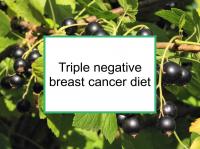Anthocyanins are dark red or purple pigments found in a variety of red, blue, purple, and black fruits, vegetables and grains. Common anthocyanins include various delphinidins, cyanidins, malvidins, peonidins, and petunidins. Consumption of anthocyanin-rich berries has been linked to reduced risk of ER- breast cancer.
Now a new study has shown how the anthocyanin cyanidin-3-glucoside interferes with the viability and metastatic potential of triple negative (ER-/PR-/HER2-) breast cancer cells.
Latest research shows how cyanidin-3-o-glucoside inhibits TN
The study referenced at the beginning of this news story was designed to investigate the chemopreventive actions of cyanidin-3-o-glucoside in triple-negative breast cancer. Anthocyanins have in been reported to inhibit the growth and metastasis of breast cancer cells. However, the actions of individual anthocyanins on triple negative breast cancer have yet to be established.
The authors determined that cyanidin-3-o-glucoside preferentially promotes the apoptosis (programmed cell death) of triple negative cells which co-express estrogen receptor alpha 36 (ERα36) and epidermal growth factor receptor (EGFR). The estrogen 17β-estradiol has been shown to promote the growth and development of some ER- breast cancers. In addition, ERα36 can influence the effects of 17β-estradiol in some triple negative breast cancer cells.
EGFR pathways have been found to mediate the migration and invasion of triple negative breast cancer cells. In the current study, the authors demonstrated that cyanidin-3-o-glucoside binds directly to ERα36, inhibits EGFR signaling, and promotes the degradation of EGFR. In addition, the authors confirmed the treatment efficacy of cyanidin-3-o-glucoside in a xenograft mouse model of triple negative breast cancer.
The authors conclude that cyanidin-3-o-glucoside could be used as a preventive/therapeutic agent in triple negative breast cancer that co-expresses ERα36 and EGFR.
Please see our article on what triple negative patients and survivors should eat for more information.
